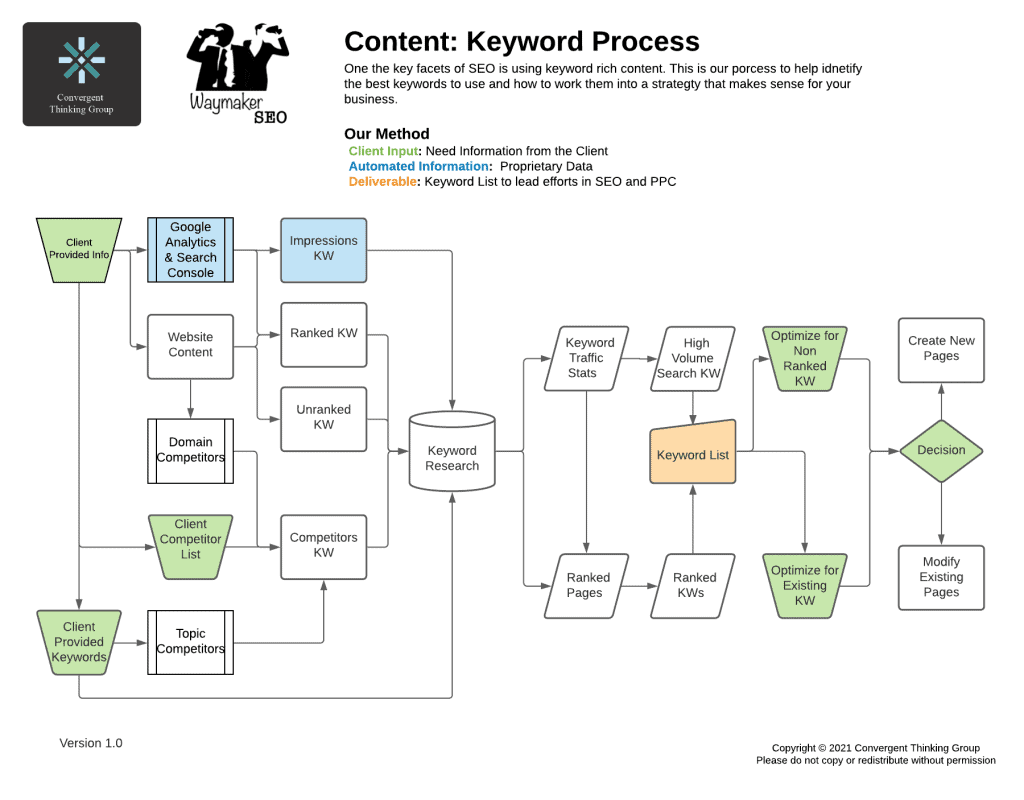One of the questions I get most often is "How do I create an SEO Content Creation Strategy" or "Write Content that helps my SEO Efforts."
This page should help as a guide for people that want to build out the content for their website in an SEO-friendly way.
SEO Content Creation Strategy
Every strategy should start with a strong understanding of your positioning and knowing which factors you can change. The following area few elements you should keep in mind:
- Be sure to get a strong understanding of your rankings, including keywords and page rankings.
- Know what words are associated with your website. You can use Google Search Console data to see what words are associated with your website.
- Have a purpose for each page on your website.
- Who is the page speaking to?
- What is the page telling them?
- What is the viewer of the page suppose to do next?
- Understand what words your competitors use.
- Identify Topic Competitors
- Identify Online Competitors
- Research other keywords that could be used to describe your product or service.
- Understand substitutes for your product or service.
- Pull as much information as you can together on 1 - 6.
Once you have all of this information, you should have a better sense of your positioning and landscape for your SEO efforts.
There are a few strategies for the data you pulled together. Below is the strategy for ranked words.
Content Strategy for SEO: Ranked Keywords
Ranked keywords are words that the Seach Engines have determined your site is associated with and essentially have ranked against other websites. To use a sports analogy, They are on the field.
Let's look at what you can do with these keywords.
Optimize Existing Content - Low hanging fruit
Your keyword ranking list will have values from 1 to 100+. Some of these words are ranked low (the higher the number, the lower-ranked you are.)
However, the words on the second page are closer to the first page, and with a little more optimization, you could move these up in ranks and over to the first page.
Here is how to evaluate and execute this strategy.
- Evaluate your page ranks and keyword rankings.
- Identify pages that are ranked over 10 and under 30.
- Identify keywords that are ranked for those pages.
- Optimize your content for specific keywords:
- Do not radically change the page. Too much change, and you could lose the value you had.
- Do not break the original intent of the page.
- Check rankings in a few weeks and see if there is a change you want.
This strategy will help you optimize existing content and reduce the chance of needing to create a bunch of new content.
Creating New Content
Even if you optimize pages, they may not be enough to move the needle on your rankings or move the needle but not enough to rank on the first page. You may need to create a new page to help the website rank better.
I would suggest you create new content for:
- Words that are ranked to the same page as other words.
- Words that are ranked on or past the 2nd search engines results page.
- Any keywords you want to rank for that are very low ranked (rank 50+).
- Words that are ranked to your home page.
- Words that are ranked for pages with no call to action.
- Long Tail Keywords that include keywords you want to rank.
- Pages that demonstrate Expertise, Authority, and Trustworthiness (EAT), as related to keywords.
- Pages that clarify your processes as related to keywords.
- Pages that help users better understand your products/services as related to keywords.
SEO efforts should dovetail your broader marketing efforts. Creating content to rank is pointless. You should create content that improves your site's ability to connect with your target audience and convert these people into potential customers.
Here is how to evaluate and execute this strategy.
- Remember Quality over Quantity; the content should improve the value of your website by improving the user experience.
- Write content for the website visitor, optimize for the Search Engines. It is better to have content people want and then tweak it for the search bots.
- If this works, how will you move visitors to the start point of their sales journey? Think of a call to action (CTA) on these new pages.
- Do some of the words "fit " better for your brand? Are the tradeoffs of using one version of a word over another worth it?
- How will you disseminate this content? Once created, are there other channels where you can use the content? (social media post?)
- Does this content fit the EAT guideline?
- How will you measure the success of this page?
Once you figured which strategy to use
You need to figure out how to get the content created, when to push it out, and when to follow up with the content.
My suggestions:
- User the same content writer you had for your other pages, or use someone that can write in a similar voice.
- Release new content on a schedule. Build consistency in your efforts.
- Follow up with your new content in two weeks. This may be shorter or longer depending on the frequency search engines visit your site.
- Once the page is indexed and ranked, watch it for a few more weeks.
- Optimize the page for specific keywords as the page move up in the ranks when you see a lull in rank progress.
This should be enough to get you started on an SEO content creation strategy. The key is to make sure that the content is working beyond just the SEO goal.
Content Strategy for SEO: Unranked Keywords
I will write up a guide for this and link it here.

